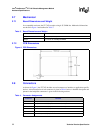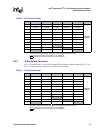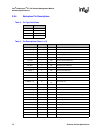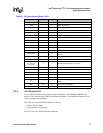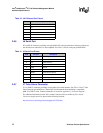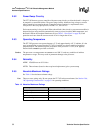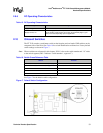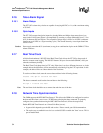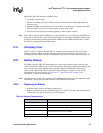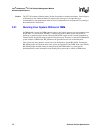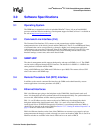
Intel
®
NetStructure
TM
ZT 7102 Chassis Management Module
Hardware Specifications
30 Technical Product Specification
2.9.2 Power Ramp Circuitry
The ZT 7102 features a power controller with power ramp circuitry to allow the board’s voltages to
be ramped in a controlled fashion. The power ramp circuitry eliminates large voltage or current
spikes caused by hot swapping boards. Controlled voltage ramping is a requirement of the
CompactPCI* Hot Swap Specification, PICMG* 2.1, Version 2.0.
Fault current sensing is also provided. When a board fault (short circuit) or overcurrent condition is
detected, the hot swap controller automatically removes power from the CMM components, and
the Status LED on the faceplate illuminates red (see Table 3, “Face Plate” on page 20). Fault
protection activates when the current exceeds 10 A for longer than 10 ms.
2.9.3 Operating Temperature
The ZT 7102 processor can operate between +5° C and approximately +65° C ambient. It is the
users' responsibility to ensure that the ZT 7102 is installed in a chassis capable of supplying
adequate airflow. The maximum power dissipation of the processor is 15 W (10 W typical).
External airflow must be provided at all times.
Caution: The processor core temperature must never exceed 100° C under any condition of ambient
temperature or usage. This may result in permanent damage to the processor.
2.9.4 Reliability
MTBF: 479,000 hours at 40° Celsius
MTTR: Three minutes (based on hot-swap board replacement), plus system startup
2.9.5 Absolute Maximum Ratings
See Table 14 for absolute maximum ratings.
Note: These are stress ratings only. Do not operate the ZT 7102 at these maximums. See Section 2.9.6,
“DC Operating Characteristics” on page 31 for operating conditions.
Table 14. Absolute Maximum Ratings
Signal or Characteristic Range
Supply Voltage, V
CC
5 V ±5% with 50 mV maximum ripple
Storage Temperature -40° to +85° Celsius
Operating Temperature +5° to +65° Celsius
Non-Condensing Relative Humidity <95% at 40° Celsius



